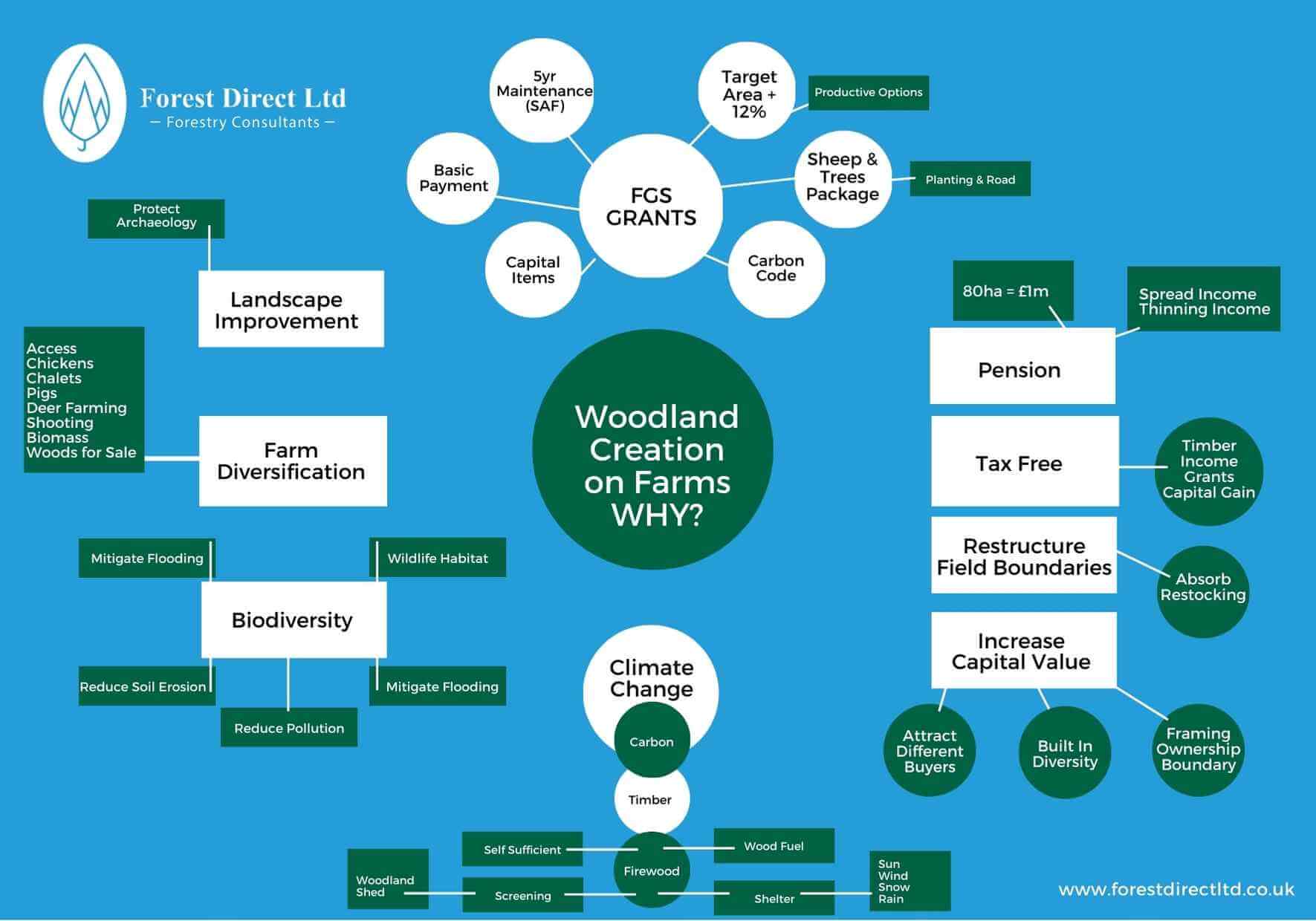Latest News
The Forestry Grant Scheme and how to navigate itThere is little point in looking at Scotland’s Forestry Grant Scheme without appreciating the broader benefits tree planting offers. There is a lot of discussion currently about woodlands to store carbon, but let’s consider the benefits to a typical farming landowner in a simple list; don’t skim through. Each heading has many layers to be considered;
- Farm shelter.
- Farm building setting and screening.
- Capital gains tax protection if productive woodland.
- Timber income.
- Fuel wood – self-sufficiency.
- Income flexibility – the timing of thinning and felling.
- Tax-free timber income.
- Development of a capital resource that is all or nearly all funded by FGS can act as a pension pot for young family members, which in the meantime offers all the other benefits as well.
- The current fixed payment is not affected.
- Increase long term property value.
- Woods are saleable as a separate package even when felled or at a young age. ( woods for sale).
- FGS can attract grants for forest road construction as well.
- Strong landscape structure, visual enhancement.
- Grants also include fences so farm layouts can be changed.
- Restock areas can be enlarged to take advantage of woodland creation grants.
- Once the wood is established, livestock is allowed back in, offering shelter and shade, ‘soft shed.’
- Climate change resilience, from gales, beast from the east, unexpected heavy snows, overheating and floods.
- Biodiversity habitat for wildlife.
- A setting for woodland paths, quadbike trails, horse gallops and rides and tourism opportunities.
- A setting for pods, ponds, species-rich areas, future holiday accommodation.
- Carbon storage and mitigation – trade the carbon as and when required, including at the beginning.
- Contribute to meeting government target and take control of your landscape setting.
- River and stream side riparian protection to reduce run off, pollution incidents and cattle poaching.
- Shelter over streams and open water with shade and partial shade, insect drop, large woody debris, and leaky dams.
- Flood prevention and flood peak flow reduction.
- Rebuilding soil structure for the long term.
- Manage woodlands for quality – which always sells.
- Manage forests for the long term – continuous woodland cover is better than plant and fell.
- Habitat for pheasants, shooting benefits.
- Business diversification when climate change and public health issues make for an unpredictable future.
- Consider woodlands as an income stream to the farm business overall, not a burden.
This list allows you to pick through your aims and objectives for any woodland you may be considering on your farmland. There is enough design flexibility in the FGS to achieve many of these objectives in one place.

What does the Forestry Grant Scheme offer?
The FGS is now about six years old, replacing the Rural Development Contracts, the Scottish Forestry Grant Scheme, and various Woodland Grant Schemes. FGS is destined to continue as it is for a few more years yet after Brexit, having achieved good overall results for The Scottish Government, helping them to meet targets.
I do not suggest it is the best scheme ever, but it is certainly not the worst. With some constraints removed from the EU (along with 50% of the funding), there is now a chance for The Scottish Government to make creative changes that can improve the FGS further without the need for EU time lag and negotiations.
Grants from Scottish Forestry cover many aspects of Forestry, not just woodland creation, although to be honest, all other grant packages are quickly overshadowed by the push for woodland creation.
- Woods in and around towns, grants for paths and woodland management next to communities of a certain size.
- Restocking grants to restock areas felled as agreed in a management plan.
- The development of a forest plan if over 100ha of woodland.
- Infrastructure grants for access to manage existing woodlands nearing harvesting age and remote.
- Small scale harvesting and wood processing.
- Tree health (Phytophthora on Larch as an example).
- Control of grey squirrels in specific locations.
- Management of native woodlands.
- Woodland grazing.
- Low impact silviculture management.
- Habitat and species protection – specific scenarios.
- Woodland creation.
There is a lot of detail to be understood behind these bullet points, and some are rarely used. There are flavours in this list, not least agroforestry, that trigger great interest in the farming sector. It is hoped that Scottish Forestry reassesses agroforestry grants very soon as the potential is considerable.
But it is good to know that under the FGS, there is possibly some funding help towards your objectives for your woodlands, but invariably it is a grant that contributes but does not cover the complete costs.
Part two of our look at the Forestry Grant Scheme will look at some of the challenges posed by the available funding schemes and how to tackle these.
If you would like to speak to a member of the Forest Direct Ltd team about woodland grants and available funding, please get in touch.
